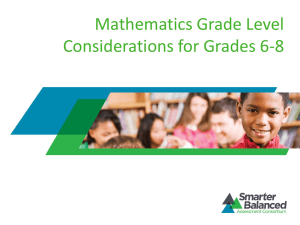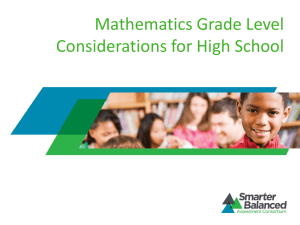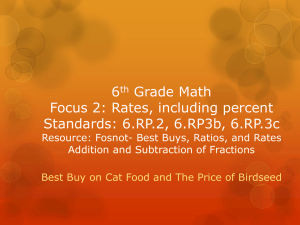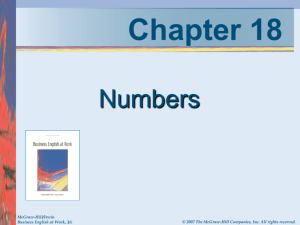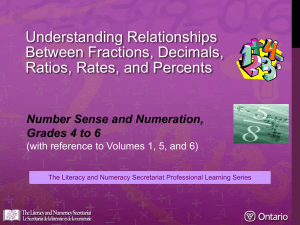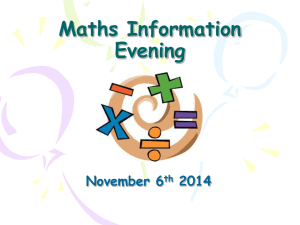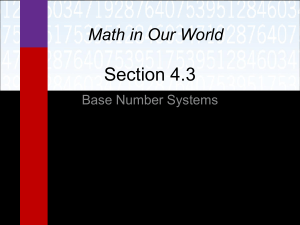Mathematics-Grade-Level-Considerations-for-Grades
advertisement
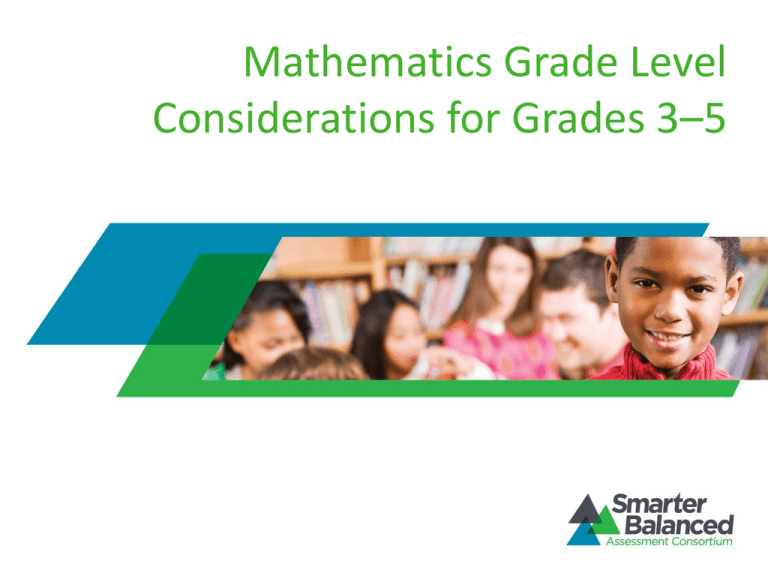
Mathematics Grade Level Considerations for Grades 3–5 Considerations for Grades 3–5 • • • • • • Vocabulary Style Guide Representation of numbers Contexts Item Difficulty Assessment Targets Vocabulary • • Items must be written so students can easily understand the item or task. Use vocabulary at or below grade-level. Style Overview of Mathematics Style Conventions for Grades 3–5 Words vs. Numerals John had 9 red balloons and 14 white balloons. How many balloons does he have in all? 19 + ____ = 35 10, 16, 22, 28, ? Words vs. Numerals • • • Use words for a number that is the first word in a sentence Use words for numbers zero through nine Use numerals for: – Numbers 10 and above – Numbers that precede abbreviated units of measure (e.g., 10 cm, 8 sq. ft.) – Numbers that precede or follow symbols such as the percent sign or dollar sign (e.g., 5%, $9.32) – Dates and years (e.g., July 4) – Time of day that appears before A.M. and P.M. (e.g., 11 A.M., 12:30 P.M.) – Ordered pairs and coordinates (e.g., (3,4)) Words vs. Numerals Example 1: Patty has 10 pennies and 3 nickels. How much money does Patty have? A. 13¢ B. 25¢ C. 40¢ D. 53¢ Example 2: The table below shows the number of cans two students collected. Student Number of Cans Sara 87 Lorenzo 59 How many more cans did Sara collect than Lorenzo? Show your work or explain how you know. Commas in Numbers • • Use commas in numbers: – With five or more digits (e.g., 90,000) – With four digits if the number appears with numbers of five or more digits (e.g., 1,000 + 5,000 + 10,000) – Written as words (e.g., seventy-three thousand, one hundred) Do not use commas in: – Numbers with four digits if all numbers with which it appears contain four or less digits (e.g., 50 + 200 + 1000) – Compound measures (e.g., 5 feet 9 inches tall) Representing Missing Values 6 + ☐ = 11 3, 5, 7, 9, ? 5×7=? Look at this equation: 3+6=? Contexts • Appropriate contexts: – Sports familiar played during physical education (basketball, soccer) – School activities (class trips, library, music, children’s games) • Inappropriate contexts: – Skiing – Backyard swimming pools – Earning money at a part-time job or saving to buy a car Item Difficulty • • Items should include a range of difficulty Anticipated difficulty for sample items Claim 1 Concepts and Procedures: Students can explain and apply mathematical concepts and interpret and carry out mathematical procedures with precision and fluency. • • • • Selected Response Constructed Response Technology-Enhanced Extended Response and Performance Tasks Assessment Targets Measured in Grades 3–5 • • • • • Operations and Algebraic Thinking Number and Operations – Base 10 Number and Operations – Fractions Measurement and Data Geometry Operations and Algebraic Thinking • • • Grade 3: Understanding meaning of multiplication and division Grade 4: Applying understanding Grade 5: Writing and interpreting numerical expressions Number and Operations – Base 10 • • • Grade 3: Using place value and properties of operations to add and subtract whole numbers Grade 4: Multiplying and dividing whole numbers Grade 5: Solving problems with decimals using the four operations Number and Operations – Fractions • • • Grade 3: Understanding of fractions as numbers Grade 4: Understand fraction equivalence and operations with fractions Grade 5: Solving problems involving the four operations Measurement and Data • • • Grade 3: Measuring time, liquid volumes, and masses of objects and solving simple one-step word problems Grade 4: Solving problems involving measurement, representing and interpreting data, and understanding angles Grade 5: Understanding volume and solving problems that involve estimating and measuring volume Geometry • • • Grade 3: Understanding that shapes in different categories may share attributes and recognizing quadrilaterals Grade 4: Classifying shapes based on properties Grade 5: Graphing points on the coordinate plane and understanding that attributes belonging to a category of two-dimensional shapes also belong to all subcategories of that category Claim 2 – Problem Solving • • • Selected Response, Constructed Response, Extended Response, and Technology-Enhanced items that focus on problem solving Items and tasks require students to construct their own pathway to the solution Relevant verbs include: – understand, solve, apply, describe, illustrate, interpret, and analyze Claim 3 – Communicating Reasoning • • Constructed Response, Extended Response, and Technology-Enhanced items and tasks that focus on mathematical reasoning Relevant verbs include: – understand, explain, justify, prove, derive, assess, illustrate, and analyze Claim 4 – Modeling and Data Analysis • • • • Performance Tasks and collections of Extended Response items Real world problems Draw upon knowledge and skills articulated in the progression of standards up to the grade being assessed Relevant verbs include: – model, construct, compare, investigate, build, interpret, estimate, analyze, summarize, represent, solve, evaluate, extend, and apply Claims 2, 3, and 4 • • Assessment Targets for Claims 2, 3, and 4 are not divided into a grade-by-grade description A general set of assessment targets applicable across grade levels Elementary School Mathematics Grade Level Considerations • • Vocabulary, style, context, and item difficulty Claims from the Smarter Balanced Mathematics Content Specifications
